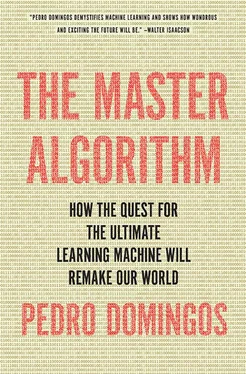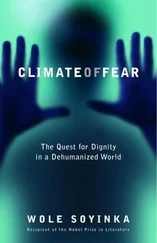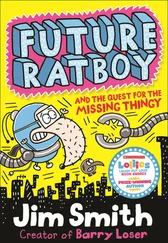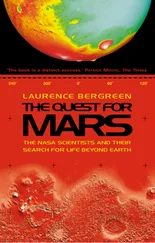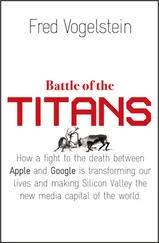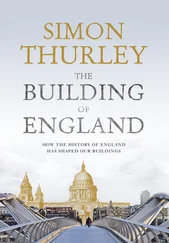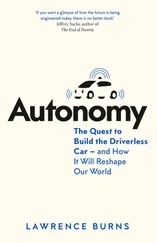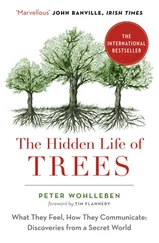Take cancer. Curing it is hard because cancer is not one disease, but many. Tumors can be triggered by a dizzying array of causes, and they mutate as they metastasize. The surest way to kill a tumor is to sequence its genome, figure out which drugs will work against it-without harming you, given your genome and medical history-and perhaps even design a new drug specifically for your case. No doctor can master all the knowledge required for this. Sounds like a perfect job for machine learning: in effect, it’s a more complicated and challenging version of the searches that Amazon and Netflix do every day, except it’s looking for the right treatment for you instead of the right book or movie. Unfortunately, while today’s learning algorithms can diagnose many diseases with superhuman accuracy, curing cancer is well beyond their ken. If we succeed in our quest for the Master Algorithm, it will no longer be.
The second goal of this book is thus to enable you to invent the Master Algorithm. You’d think this would require heavy-duty mathematics and severe theoretical work. On the contrary, what it requires is stepping back from the mathematical arcana to see the overarching pattern of learning phenomena; and for this the layman, approaching the forest from a distance, is in some ways better placed than the specialist, already deeply immersed in the study of particular trees. Once we have the conceptual solution, we can fill in the mathematical details; but that is not for this book, and not the most important part. Thus, as we visit each tribe, our goal is to gather its piece of the puzzle and understand where it fits, mindful that none of the blind men can see the whole elephant. In particular, we’ll see what each tribe can contribute to curing cancer, and also what it’s missing. Then, step-by-step, we’ll assemble all the pieces into the solution-or rather, a solution that is not yet the Master Algorithm, but is the closest anyone has come, and hopefully makes a good launch pad for your imagination. And we’ll preview the use of this algorithm as a weapon in the fight against cancer. As you read the book, feel free to skim or skip any parts you find troublesome; it’s the big picture that matters, and you’ll probably get more out of those parts if you revisit them after the puzzle is assembled.
I’ve been a machine-learning researcher for more than twenty years. My interest in it was sparked by a book with an odd title I saw in a bookstore when I was a senior in college: Artificial Intelligence . It had only a short chapter on machine learning, but on reading it, I immediately became convinced that learning was the key to solving AI and that the state of the art was so primitive that maybe I could contribute something. Shelving plans for an MBA, I entered the PhD program at the University of California, Irvine. Machine learning was then a small, obscure field, and UCI had one of the few sizable research groups anywhere. Some of my classmates dropped out because they didn’t see much of a future in it, but I persisted. To me nothing could have more impact than teaching computers to learn: if we could do that, we would get a leg up on every other problem. By the time I graduated five years later, the data-mining explosion was under way, and so was my path to this book. My doctoral dissertation unified symbolic and analogical learning. I’ve spent much of the last ten years unifying symbolism and Bayesianism, and more recently those two with connectionism. It’s time to go the next step and attempt a synthesis of all five paradigms.
I had a number of different but overlapping audiences in mind when writing this book.
If you’re curious what all the hubbub surrounding big data and machine learning is about and suspect that there’s something deeper going on than what you see in the papers, you’re right! This book is your guide to the revolution.
If your main interest is in the business uses of machine learning, this book can help you in at least six ways: to become a savvier consumer of analytics; to make the most of your data scientists; to avoid the pitfalls that kill so many data-mining projects; to discover what you can automate without the expense of hand-coded software; to reduce the rigidity of your information systems; and to anticipate some of the new technology that’s coming your way. I’ve seen too much time and money wasted trying to solve a problem with the wrong learning algorithm, or misinterpreting what the algorithm said. It doesn’t take much to avoid these fiascoes. In fact, all it takes is to read this book.
If you’re a citizen or policy maker concerned with the social and political issues raised by big data and machine learning, this book will give you a primer on the technology-what it is, where it’s taking us, what it does and doesn’t make possible-without boring you with all the ins and outs. From privacy to the future of work and the ethics of roboticized warfare, we’ll see where the real issues are and how to think about them.
If you’re a scientist or engineer, machine learning is a powerful armory that you don’t want to be without. The old, tried-and-true statistical tools don’t get you far in the age of big (or even medium) data. You need machine learning’s nonlinear chops to accurately model most phenomena, and it brings with it a new scientific worldview. The expression paradigm shift is used too casually these days, but I believe it’s not an exaggeration to say that that’s what this book describes.
If you’re a machine-learning expert, you’re already familiar with much of what the book covers, but you’ll also find in it many fresh ideas, historical nuggets, and useful examples and analogies. Most of all, I hope the book will provide a new perspective on machine learning and maybe even start you thinking in new directions. Low-hanging fruit is all around us, and it behooves us to pick it, but we also shouldn’t lose sight of the bigger rewards that lie just beyond. (Apropos of which, I hope you’ll forgive my poetic license in using the term master algorithm to refer to a general-purpose learner.)
If you’re a student of any age-a high schooler wondering what to major in, a college undergraduate deciding whether to go into research, or a seasoned professional considering a career change-my hope is that this book will spark in you an interest in this fascinating field. The world has a dire shortage of machine-learning experts, and if you decide to join us, you can look forward to not only exciting times and material rewards but also a unique opportunity to serve society. And if you’re already studying machine learning, I hope the book will help you get the lay of the land; if in your travels you chance upon the Master Algorithm, that alone makes it worth writing.
Last but not least, if you have an appetite for wonder, machine learning is an intellectual feast, and you’re invited-RSVP!
CHAPTER ONE: The Machine-Learning Revolution
We live in the age of algorithms. Only a generation or two ago, mentioning the word algorithm would have drawn a blank from most people. Today, algorithms are in every nook and cranny of civilization. They are woven into the fabric of everyday life. They’re not just in your cell phone or your laptop but in your car, your house, your appliances, and your toys. Your bank is a gigantic tangle of algorithms, with humans turning the knobs here and there. Algorithms schedule flights and then fly the airplanes. Algorithms run factories, trade and route goods, cash the proceeds, and keep records. If every algorithm suddenly stopped working, it would be the end of the world as we know it.
An algorithm is a sequence of instructions telling a computer what to do. Computers are made of billions of tiny switches called transistors, and algorithms turn those switches on and off billions of times per second. The simplest algorithm is: flip a switch. The state of one transistor is one bit of information: one if the transistor is on, and zero if it’s off. One bit somewhere in your bank’s computers says whether your account is overdrawn or not. Another bit somewhere in the Social Security Administration’s computers says whether you’re alive or dead. The second simplest algorithm is: combine two bits. Claude Shannon, better known as the father of information theory, was the first to realize that what transistors are doing, as they switch on and off in response to other transistors, is reasoning. (That was his master’s thesis at MIT-the most important master’s thesis of all time.) If transistor A turns on only when transistors B and C are both on, it’s doing a tiny piece of logical reasoning. If A turns on when either B or C is on, that’s another tiny logical operation. And if A turns on whenever B is off, and vice versa, that’s a third operation. Believe it or not, every algorithm, no matter how complex, can be reduced to just these three operations: AND, OR, and NOT. Simple algorithms can be represented by diagrams, using different symbols for the AND, OR, and NOT operations. For example, if a fever can be caused by influenza or malaria, and you should take Tylenol for a fever and a headache, this can be expressed as follows:
Читать дальше
